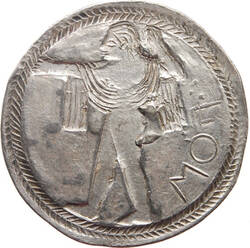The coin you see here is one of the oldest in our collection. It is from the very early days of the art of minting.
The first coins started to appear in western Asia Minor in around 630 BC. Being very easy to handle, they soon spread throughout the Mediterranean, including Southern Italy. Where Greek immigrants were establishing new cities: Metapontum, Tarentum, Kroton, Sybaris – and the city of Poseidonia in the ancient region of Lucania. To this day, the remains of vast temple ruins tell of its former wealth. They include a complex known as the Temple of Poseidon. The city was not only named after Poseidon, he was also its main deity. So naturally, his image would have been prominent on coins from Poseidonia.
This stater (the term means something like "uniform piece") is from the first phase of coining in Poseidonia. The artistic quality is especially high, because it shows the sea god Poseidon as a complete figure – the first time in the history of Greek die-cutting that that had been achieved.
The bearded sea god is seen striding towards the right, with a short mantle – or chlamys – draped across his upper arms. He holds his trident in his raised right hand. The reverse shows the same subjects in intaglio, in other words sunk below the surface. Nevertheless, this coin was struck using two dies. The Greek letters pi, omicron and sigma, P O S, name the authority that commissioned the coin: the city of Poseidonia.
Further Media
- Location & Dating
- Lucania, n.d. (ca. 530-500 BC)
- Material & Technique
- Silver, embossed
- Dimenions
- Durchmesser: 28,8 mm; Gewicht: 7,44 g
- Museum
- Münzkabinett
- Inventory number
- AAB372
